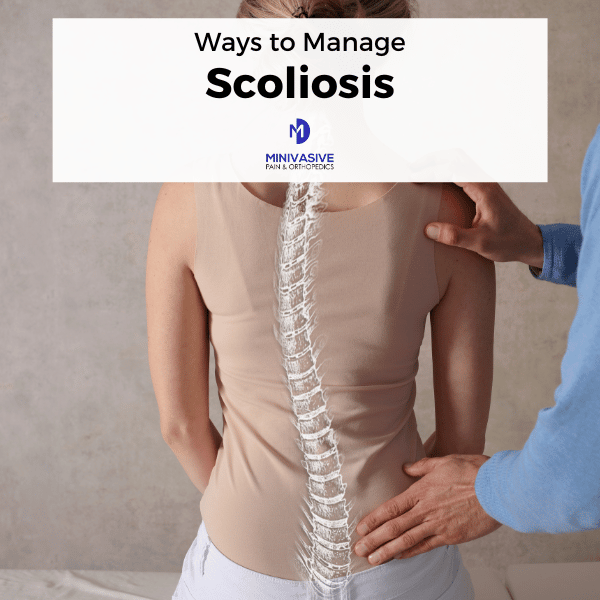June is National Scoliosis Awareness Month. Scoliosis is a condition of the spine, and it occurs when the spine twists or curves to one side. This curvature can pull the ribcage out of place, and strain the back muscles, causing a great deal of pain and discomfort to the patient. Unfortunately, scoliosis is a common condition that affects over 7 million people in the United States alone. Although it most often appears in children, the disease can surface at any time. Learn more about scoliosis causes, symptoms and treatment options below.
Causes of Scoliosis
Like we mentioned above, scoliosis most often develops in children, but it can begin to show up later in life as well. Someone with the diagnosis could have:
- been born with it (congential)
- develop it as a young child (early onset)
- develop it as an older child or teenager (adolescent idiopathic)
- develop it as an adult (degenerative or de novo)
As one might imagine, a curved spine can be incredibly painful. This is due to muscle pain as well as the added pressure on your spinal discs and facet joints. The curve of the spine itself can also cause irritated nerves and inflammation.
Symptoms of Scoliosis
During the earliest onset of the disease, a patient may not notice any symptoms, especially if they are a child. It can often go undetected in children until they reach their rapid growth phase in adolescence.
Scoliosis can be more difficult to diagnose in adults, as it can often be mistaken for back pain. This is particularly true for the milder cases.
Poorly-fitting clothes can point to having the disease, as well as these other symptoms:
- Uneven hips
- Abnormal posture
- Head uncentered on the body
- One shoulder blade higher than the other
- Visibly curved spine
Scoliosis can also cause back pain, fatigue, and stiffness. It’s time to consult a physician if you have back pain that lasts longer than a week and doesn’t improve with at-home treatments, pain that feels like it’s shooting down your legs, or pain that stops you from living the joys of your day-to-day life.
Diagnosis
Scoliosis is a complex disease that requires diagnosis by a medical provider. With the proper intervention, your doctor can stop the spinal curvature from worsening.
The first thing your doctor will do is ask you a thorough list of questions about your medical history and symptoms. They’ll check for any relevant family history before performing a physical exam. During the physical portion of the test, they’ll have you bend forward and swing your arms loose with your hands touching. They will then check your back and ribs for any unevenness,
If your doctor finds a spinal curve, they’ll order an X-ray to accurately measure the curve of your spine. They may also use a special device called a scoliometer to check to see if your spine has rotated.
Treatment
The best way to treat scoliosis pain is to treat the cause of the disease itself. Fortunately, there are various treatments available, depending on a patient’s level of pain.
- Medication: Acetaminophen or ibuprofen can help relieve pain. If that doesn’t help, your doctor may prescribe an antidepressant to help with both your pain and mood.
- Complementary therapy: This includes massage therapy, supportive braces or low-impact exercise meant to help stretch and relax your muscles such as swimming, pilates, yoga and stretching.
- Chiropractic treatment: While your chiropractor can’t cure scoliosis, they can help relieve back pain by increasing your flexibility. Note: patients should be sure to find a chiropractor who specializes in scoliosis treatment, as someone who is untrained has the potential to make the condition worse.
- Counseling: Cognitive behavioral therapy is sometimes used to help patients who are struggling with chronic pain. This therapy provides coping mechanisms that can help patients manage their pain in a healthy way.
- Nerve Stimulation: If a patient is dealing with pain caused by damaged nerves, a transcutaneous electrical nerve stimulation device can be used to help treat the pain.
- Steroid Injections: Your doctor may inject steroids around your spinal joints and nerves to help ease pain. Unfortunately, steroids don’t have a long-term effect on pain and should only be used to treat acute problems, or as a part of a larger treatment plan.
Scoliosis Pain Management at Minivasive Pain and Orthopedics
At Minivasive Pain, we have a dedicated staff of pain management specialists. No matter the severity of your pain caused by scoliosis, it is our mission to treat the causes with both the highest standards of care and quality. Our dedicated team of physicians is ready to help you devise a treatment plan that works best for you, and gets you back to the joys of your life.
With several pain management centers throughout the Houston area, caring for your pain is what we do every day. To learn more, or to schedule an appointment, visit https://minivasivepain.com/contact-us/ or call us at (346) 800-6001.

